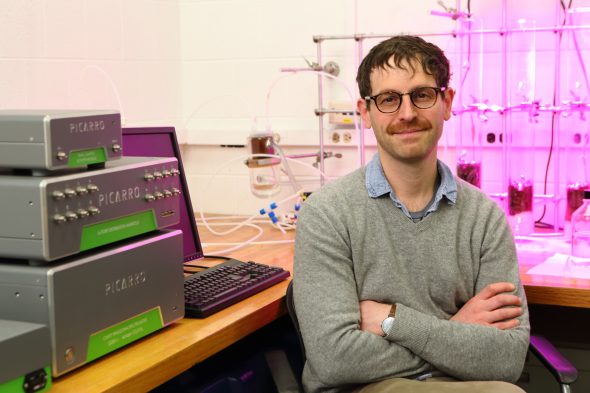East Meets West: Collaborators use water measurement tools to understand athletic performance
What do calories and ecosystems have in common?
Water can be used to answer questions about both.
Max Berkelhammer, climate scientist and assistant professor of earth and environmental sciences, tracks the movement of water to understand the global water cycle.
“We use tracers, which are molecules that allow us to track water as it moves through the planet,” Berkelhammer said of his research processes.
Tracers and an instrument known as a laser absorption spectrometer can help scientists track water movement through plants, the ocean, and rivers or streams.
Berkelhammer and Craig Horswill, clinical associate professor of kinesiology and nutrition, are using this gold standard of measurement in a novel way — to look at athlete energy expenditure and muscle mass, two things that affect athletic performance.
“We know that much of our muscle is made up of water,” said Horswill, “so I’m very interested in the technology of assessing and understanding that, how to measure something in our lean
tissue, how that affects our estimate of body fats.”
Horswill is testing the feasibility of the method and comparing outcomes of UIC gymnasts and swimmers.
Athletes are given a fixed amount of a benign water tracer, then blood and urine samples are taken, filtered and analyzed by the laser absorption spectrometer, which is based in Berkelhammer’s lab.
“One of the tracers attaches to hydrogen in water,” explained Berkelhammer. “The other is attached to the oxygen in water. The body metabolizes both differently, so those tracers follow slightly different pathways.”
The laser absorption spectrometer detects the presence of these tracers in the water.
“You take your sample, heat it up above the boiling point so it’s water vapor, and then a laser is shone through that water vapor,” Berkelhammer said. “The tracers absorb some of that energy from the laser, so we’re able to relate that to the amount of tracer in a sample.”
The difference between the tracer’s turnover rates tells researchers how many calories athletes burn, which is used to calculate energy expenditure. The results could help researchers determine how many calories an athlete should be consuming to maintain energy levels and body mass.
“The swimmers tend to have more water in their bodies than the gymnasts,” Horswill said, sharing what he, Berkelhammer and their students have found through their research so far.
In swimmers, fat may be important for buoyancy. Less fat in gymnasts, however, may allow those athletes to perform better on land.
“Water content can affect your prediction of net fat mass in those individuals,” Horswill added.
The assessment method could guide more research or the applications of that work in areas related to hydration, energy balance and body composition.
“It’s important because this method has never been developed at the UIC campus,” said Ulani Villanueva, a pre-nutrition student and research assistant for part of the project. “Developing the method would open doors for doing studies, improving project oversight, reducing costs and increasing collaborations.”
Categories
Research, Top Faculty Staff News
Topics
athlete, athletic performance, earth and environmental sciences, East Meets West, kinesiology, nutrition, water


